Related Research Articles
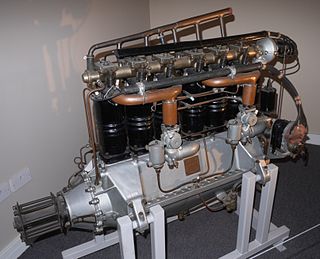
The Rolls-Royce Hawk was a British aero engine designed by Rolls-Royce in 1915. Derived from one bank of six cylinders of the Rolls-Royce Eagle, it produced 75 horsepower at 1,370 rpm. Power was progressively increased to 91 hp by February 1916, and 105 hp by October 1918.

The N series is Honda's first automotive diesel engine, an inline-four for medium-sized vehicles. It uses common rail direct injection, which Honda brands as i-CTDi. The most notable feature is the aluminium block, which uses proprietary technology in the manufacturing process to provide light weight and high rigidity. Roller chains drive two overhead camshafts. A variable-geometry turbocharger and intercooler are used.

The BMW VI was a water-cooled V-12 aircraft engine built in Germany in the 1920s. It was one of the most important German aero engines in the years leading up to World War II, with thousands built. It was further developed as the BMW VII and BMW IX, although these saw considerably less use. It was also produced in the Soviet Union as the M-17 and Japan as the Kawasaki Ha-9.
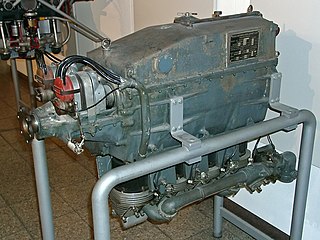
The Argus As 8 was a four-cylinder, air-cooled, inverted inline aircraft engine produced in Germany by Argus Motoren in the 1930s.

The Alfa Romeo 110 was an Italian four cylinder air-cooled inverted inline engine for aircraft use, mainly for trainers and light aircraft. The Alfa Romeo 110 was based on the de Havilland Gipsy Major, with approximately 500 units produced. Derivatives of the 110 include the -1, ter and Alfa Romeo 111.

The Hirth HM 504 is a four-cylinder air-cooled inverted inline engine. The HM 504 was a popular engine for light aircraft of the 1930s-1940s, and it was used to power a number of Germany's trainer aircraft of World War II. The engine featured a cast magnesium alloy crankcase. The Hitachi Hatsukaze Model 11 was a Japanese licensed version.
The Hirth HM 506 was a six-cylinder air-cooled inverted inline engine that was developed from the earlier four-cylinder HM 504. The HM 506 was a popular engine for light aircraft of the 1930s to 1940s and powered the Bücker Bü 133A model trainer. The engine featured a cast magnesium alloy crankcase.
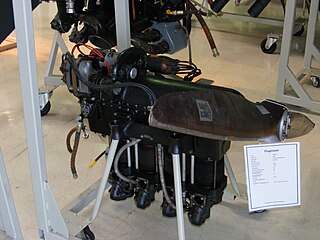
The Hirth HM 60 was a four-cylinder inverted air-cooled inline aircraft engine designed in 1923 and first sold in 1924. The engine was of very high quality, and its sales success contributed to Hirth's rapid pre-war expansion. It was a popular engine for light aircraft delivering 80 hp (60 kW) at 2,300 rpm. Later Hirth engines built upon the HM 60's success and provided greater power with many of the same design features.

The Beardmore Tornado was an eight-cylinder inline diesel aircraft engine built in 1927 by William Beardmore and Company of Glasgow, Scotland, and used in the British R101 airship when petrol engines were thought unsafe in the tropics. The model is given as Tornado IIIA or Tornado III C.I. The fuel is described as Diesel heavy-oil..

The Daimler-Benz DB 602, originally known as Daimler-Benz LOF.6, was a German diesel cycle aero engine designed and built in the early 1930s. It was a liquid-cooled upright V16, and powered the two Hindenburg class airships. It has roughly the same displacement and weight of the Beardmore Tornado, which was used in the ill-fated R101, but has almost twice the power of the Tornado, showing Daimler-Benz's superior knowledge regarding diesel engine construction.

The Beardmore 120 hp was a British six-cylinder, water-cooled aero engine that first ran in 1914, it was built by William Beardmore and Company as a licensed-built version of the Austro-Daimler 6. The engine featured cast iron cylinders and mild steel concave pistons. Produced between August 1914 and December 1918, the design powered many World War I aircraft types.
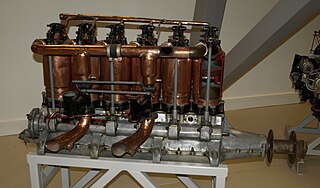
The Beardmore 160 hp is a British six-cylinder, water-cooled aero engine that first ran in 1916, it was built by Arrol-Johnston and Crossley Motors for William Beardmore and Company as a development of the Beardmore 120 hp, itself a licensed-built version of the Austro-Daimler 6.

The Sunbeam Cossack was a British 12-cylinder aero engine that was first run in 1916. The Cossack spawned a family of engines from Sunbeam.
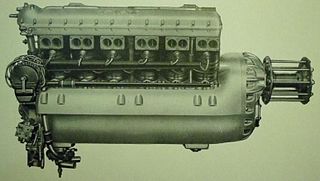
The Fiat A.24 was an Italian water-cooled aircraft engine from the 1920s, built in modest numbers. It produced 520 kW (700 hp).
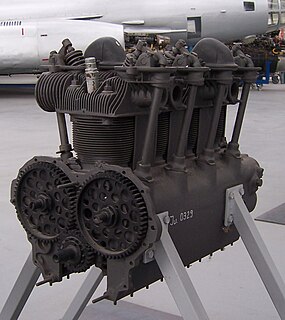
The Zündapp 9–092 or Z 92 was a German four-cylinder, air-cooled, inline aero engine made by Zündapp and used in light aircraft of the late-1930s.

The Walter Junior was a family of four cylinder air cooled horizontally-opposed engines produced by Walter Aircraft Engines in Czechoslovakia in the 1930s for aircraft, characterised by a bore and stroke of 115 mm × 140 mm, a displacement of 5,814 cm3 (354.8 cu in) and producing roughly 78 kW (105 hp).

The Potez 6D is a French six cylinder inverted inline aircraft engine put into production after World War II in normal and supercharged versions. Unsupercharged, it produced a take-off power of 179 kW (240 hp) at 2,530 rpm.
The Potez 8D is the largest member of the Potez D series of air-cooled piston aircraft engines which share several common features. It is a supercharged eight cylinder inverted engine with a take-off power of 373 kW (500 hp).

The Isotta Fraschini Asso 750 was an Italian W 18 water-cooled aircraft engine of the 1930s. Produced by Isotta Fraschini the engine displaced just under 48 l (2,900 cu in) and produced up to 940 hp (700 kW). Together with the Asso 200 and the Asso 500 the Asso 750 was part of a family of modular engines, that used common and interchangeable components to lower production costs.
References
- 1 2 "Beardmore Cyclone, Typhoon, and Simoon" . Retrieved 16 December 2013.
- 1 2 "THE BEARDMORE "CYCLONE" AERO ENGINE: 900 H.P. at 1,350 R.P.M". Flight: 717–718. 4 November 1926. Retrieved 8 March 2018.
- ↑ "The Beardmore "Typhoon" Mark I Engine". Flight: 44–45. 7 January 1927. Retrieved 8 March 2018.
- ↑ Masefield, Sir Peter G. (1982). To ride the storm : the story of the airship R.101. London: W. Kimber. p. 464. ISBN 978-0718300685.